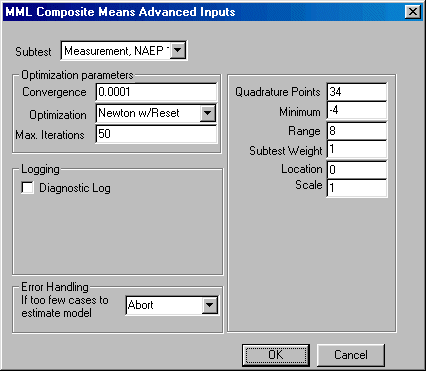This procedure derived from MML Composite Regression.
Two variants of this procedure are available. The basic procedure assumes that all groups share the same variance. The MML Composite Means (Separate Variances) procedure estimates a separate mean and variance for each group. Essentially, this is the same as estimating a separate composite regression with only a constant term for each group; however, the standard errors may covary across groups in complex samples.
This procedure is derived from MML Composite Regression . It automatically dummy-codes the independent variables, creating categories for all possible crossings.
Two variants of this procedure are available. The basic procedure assumes that all groups share the same variance. The MML Composite Means (Separate Variances) procedure estimates a separate mean and variance for each group. Essentially, this is the same as estimating a separate composite regression with only a constant term for each group; however, the standard errors may covary across groups in complex samples.
This procedure assumes a common covariance across scales among the groups.
To run MML Composite Means, left-click on the Statistics menu and select "MML Composite Means." The following dialogue box will open:

Specify the independent variables and the dependent variable. You may also elect to change the design variables, elect to suppress the constant, and select the desired output format.
If you wish to change the default values of the program, click the Advanced button in the bottom left corner and the Advanced parameters dialogue box shown here will open:

You may now edit the values for quadrature points, minimum, range, subtest weight, convergence, maximum number of iterations allowed for convergence, and change the default optimization method. You may elect to create a diagnostic log and whether you would prefer the program to abort the analysis or issue a warning when the data contains too few cases per cell to estimate the model.
When you are finished, click the OK button.
Click the OK button on the MML Composite Means dialogue box to begin the analysis.
Once the analysis is completed, you may perform either t-tests or correlations among equations on the results.